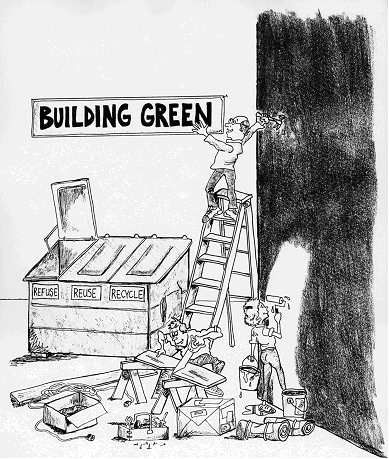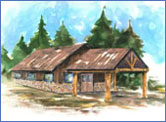
Everyone who builds a home on a pristine lake or in a secluded area of the woods, or invests in urban-sprawl development, is a part of the same global pattern of encroachment that displaces wildlife and decreases the wild space our own species needs for its survival.
- Deanna Morrison
One of the more onerous problems facing Owners making Design/Build decisions is what to do with construction and demolition (C&D) waste. One has only to drive-by any construction site and see the unattractive pile of debris accumulated to be convinced of this concern. Considering that construction of a single family residence generates about 2.5 tons of C&D waste, this debris quickly becomes an economic problem costing from $500 to $1,000 for scrap removal from a job site, not to mention what it takes to clean-up the job on a daily and weekly basis.
The solution is for Owners to apply the FOUR R's of the "building green" philosophy to their debris:
* REDUCE the amount of C&D waste you generate.
* REUSE what is reusable (or find someone who will).
* RECYCLE what's left on site.
* REFUSE belongs in a landfill.
Keep in mind...the problem is not just an economic issue but a moral issue, and like most moral decisions the choice to follow the FOUR R's is difficult compared to the ease of renting a mammoth metal container and chucking all debris over the side for the duration of the project. Our concern is for the conservation of natural resources while decreasing material and disposal costs.

HERE'S WHAT YOU CAN DO DURING THE DESIGN / BUILD PROCESS:
During the Design Phase:
- Research publications and sources which will assist in your efforts to conserve. Contact your city or county government for assistance.
- Specify slab-on-grade foundations, adopt panelized construction, and adjust the floor plans and roof pitches of your home to fit a two foot grid.
- Incorporate design features which utilize standard sizes of materials such as lumber in 8', 10', 12' lengths; C/D Exterior (CDX) plywood or Oriented Strand Board (OSB) in 4'x 8' modules.
- Change the way you design a house by following a value-engineered approach that takes advantage of more efficient layout and spacing at corners, joists, headers, top plates, and backing.
- Consider the use of salvaged windows, doors, electrical or plumbing fixtures if they are code compliant. Items such as "flawed" tiles and second-hand wood floor strips may be available. Hardware can often be found at neighborhood garage sales.
- Make sure job site recycling and clean-up is written in your contract with Trade Contractors. Remember: your program will fail without the support of the people who actually do the work.
- Dedicate an area on site for recycle-reuse bins. Take into consideration logistics required for excavation, material storage, job shack, utility access, job toilet, and parking area before locating bins.
During the Build Phase:
- Clearly designate bins by attaching large identification signs. Consider using a single bin with dividers.
- Provide a trash can for lunch bags, coffee cups, caulking tubes, and other items which will contaminate the load and make it unacceptable for recycling.
- Consider locking bins at night and on weekends to prevent people from dumping their trash in your recycling bins.
- Centralize wood-cutting operations to make it easier to locate and reuse end cuts and scrap plywood. When cutting is done in other areas, relocate your scrap pile so people won't walk long distances to reuse end cuts.
- Figure out which categories of waste your project will generate (i.e., dimensional lumber, drywall, cardboard, asphalt, metal, masonry, concrete, plastic). Coordinate regular pick-ups/deliveries to eliminate overflowing bins or huge piles.
- Contact Construction Manager (or Superintendent) and Trade Contractors as each phase approaches to review the Conditions of your Agreement. As crews come on the site, talk to the lead person to remind them of your reduce-reuse-recycle-refuse program.
- Look for haulers willing to cooperate. If they drag their feet, look for someone else. Make sure haulers who say they recycle aren't actually dumping your waste illegally.
- Donate used building materials to non-profit building centers like Habitat for Humanity's Re-Store, which are willing to handle job site leftovers.
Building your homestyle is just the first step toward creating your lifestyle, and by "building green" you're providing a HABITAT for "living green." Understanding your home as an ecosystem represents a concern for how the basic elements of air, water, energy, and materials interact with nature in a manner consistent with our biological system.
On an economic basis we're interested in efficient operations that save money. But during the construction process, we may be creating hazardous conditions caused by the very technology that was designed to improve our lives. Chemical vapors from materials used during installation and synthetic manufacturing materials used on products may contribute to an unhealthy living environment. Your responsibility is to determine whether the materials and products for your homestyle will become detrimental to your lifestyle.
The effectiveness of your home design will marry site to lifestyle but a healthy indoor climate creates an additional "hidden" value. Due to energy and building codes, the modern house is sealed tight with concrete floors, vapor barriers, airtight windows and doors, and layers of paints, stains, and floor coverings. More than likely, the materials/products with which you build will contribute to the environment in which you live.
Your challenge will be to choose products/materials for your HABITAT which will complement good health. Remember: Use "green" products and materials that are nontoxic, nonpolluting, low energy, and recyclable.
The Design/Build process allows the Owner to slowly progress towards a final solution so there's every opportunity to consider your community, site, architectural style, materials, products, and decor.
Being in harmony with home and life style will bring satisfaction to how you build and live.
Here are some building green categories that present an opportunity to introduce healthier products and more efficient practices into your home and life style during the Design/Build process:
- Energy Star Rating from your local utility provider
- Model Energy Code from your local building department
- Land Use, such as reusing site topsoil and orienting house properly on lott
- Waste Management, such as built-in kitchen recycling center
- Building Envelope, such as advanced sealing practices around windows and doors
- Mechanical System, such as high efficiency furnace with zone heating/cooling
- Indoor Air Quality, such as house meeting American Lung Association's Health House Standards
- Water Heating, such as water heater with insulating blanket installed to mfr's specs
- Appliances meeting Energy Star Rating
- Lighting, such as efficient, fluorescent light bulbs throughout house
- Structural Frame utilizes engineered lumber products rather than dimensional products
- Doors, such as insulated garage and exterior doors
- Windows, such as double-glazed, Low-E with insulated window coverings
- Cabinetry made with formaldehyde-free particleboard and adhesives
- Wall Paints and Finishes with minimal VOC content
To complete your "personal" ecosystem, an Owner will want to develop the building site in a manner which is environment-friendly. How one controls storm water, creates green spaces, allows for driveways and sidewalks, provides spaces for septic and potable water, and orients the residence to the sun will unify the design within and without the home.
This environmental effort goes beyond county or municipal ordinances covering setback requirements, green spaces, wetlands, or conditions, covenants, and restrictions established by neighborhood associations. Although these are legitimate issues which will be considered when you apply for a building permit, and certainly need to be addressed even before you purchase a lot, these technical issues are only part of a complete master plan of your site.
Your master plan will be determined by characteristics of the topography, soil, weather, vegetation, size and shape of the site, zoning regulations, utilities, off-site features, and how the Owner intends to use the outdoor space once the home is completed.
For proper ecological management, the Owner may want to involve the professional services of a Landscape Architect or Civil Engineer especially if the site presents complex conditions which make a profound impact on issuance of a building permit. However, if site conditions don't pose difficult technical issues, the Owner may proceed using common sense and their own definition for what is suitable to their home and life style.
The key to creating an environment-friendly site is working with the processes of both biological and technological systems.
First, the Owner will want to examine existing biological and geological conditions as thoroughly and precisely as possible. Second, you'll want to become familiar with seasonal weather patterns which affect the geographical area and specifically your site. Thirdly, account for ALL utility requirements regarding ingress and egress, and any legal requirements which may affect development. A fourth step would be to layout traffic flow to and from the site both during and after construction. Fifth, place the residence in a location which allows for all the information generated by the previous four steps. Sixth, co-opt all contractors and suppliers in your initiative to properly handle material and debris disposal. Finally, utilize the FOUR R'S of the building green philosophy for handling construction and demolition waste.
A natural, technically "correct" site satisfies all requirements by the local building department while producing a healthy, clean, and safe building site. There's no pat formula for making this happen so be prepared to define and analyze the conditions of your site. Remember: it's a process of progressively approximating solutions for your project.
All decisions in the Design/Build process make a statement about what you value and its impact on the community.
|




